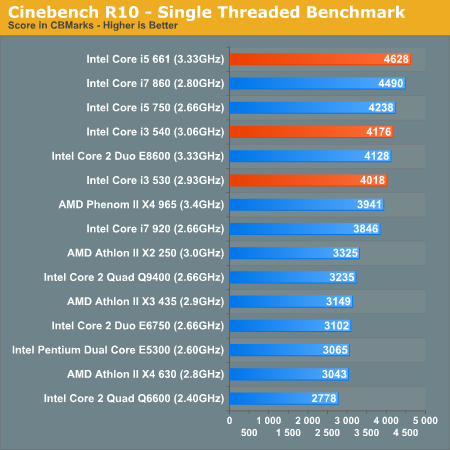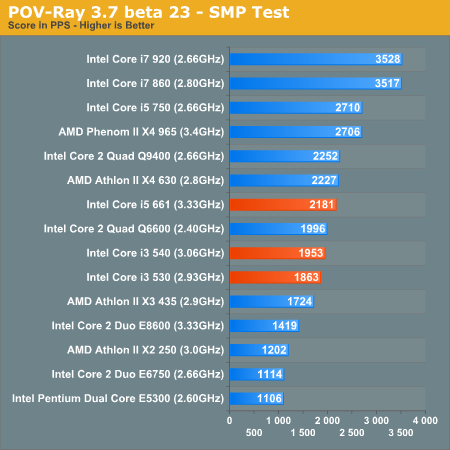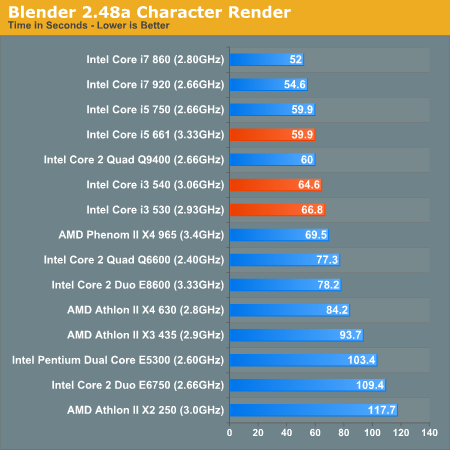The Clarkdale Review: Intel's Core i5 661, i3 540 & i3 530
by Anand Lal Shimpi on January 4, 2010 12:00 AM EST- Posted in
- CPUs
3dsmax 9 - SPECapc 3dsmax CPU Rendering Test
Today's desktop processors are more than fast enough to do professional level 3D rendering at home. To look at performance under 3dsmax we ran the SPECapc 3dsmax 8 benchmark (only the CPU rendering tests) under 3dsmax 9 SP1. The results reported are the rendering composite scores:

As with video encoding, this sort of test greatly benefits from more CPU cores. The 661 places just below the Q9400 while the i3 parts place at or below the level of an old Q6600. All the new parts are faster than the Core 2 Duo CPUs, but that's as good as it gets.
Cinebench R10
Created by the Cinema 4D folks we have Cinebench, a popular 3D rendering benchmark that gives us both single and multi-threaded 3D rendering results.

Clarkdale's saving grace is its single threaded performance. The 661 can run at up to 3.60GHz when only a single thread is active, giving it better single threaded performance than anything else on the chart here. The majority of desktop performance is still bound by the performance of a single thread. That's where Clarkdale will shine.
Even the turbo-less i3s do very well here despite their "low" clock speed. The i3 530 is almost as fast as a 3.33GHz Wolfdale and slightly faster than a Phenom II 965. The low latency L2 helps Clarkdale a lot here.

There's no substitution for more cores. Run four CPU intensive threads and Clarkdale loses its edge.
POV-Ray 3.73 beta 23 Ray Tracing Performance
POV-Ray is a popular, open-source raytracing application that also doubles as a great tool to measure CPU floating point performance.
I ran the SMP benchmark in beta 23 of POV-Ray 3.73. The numbers reported are the final score in pixels per second.

POV-Ray is the worst for Clarkdale. Even the Athlon II X4 630 can outperform the i5 661. The i3s are pretty close in performance to the 661 though, they at least offer a better value.
Blender 2.48a
Blender is an open source 3D modeling application. Our benchmark here simply times how long it takes to render a character that comes with the application.

Blender is the opposite of POV-Ray, showing more of a best-case for 3D rendering on Clarkdale. The 661 still doesn't make sense based on price, but the i3 parts surpass everything except the Q9400 in this test.










93 Comments
View All Comments
Marcin - Monday, January 4, 2010 - link
2D loadAnand Lal Shimpi - Monday, January 4, 2010 - link
The Radeon HD 5870 is quite power efficient if it's not running a 3D app. Our load tests were done using our x264 encoding benchmark to stress the CPU. That's why I used the 5870 as a companion in those benchmarks - makes overall system power consumption lower so we can better see differences between CPUs. Good job AMD :)Take care,
Anand
yacoub - Monday, January 4, 2010 - link
Intel gives us this crap instead of 32nm P55.DrMrLordX - Monday, January 4, 2010 - link
Can we see results on an i3 530 instead? Some people with ES chips are reporting that i3s are not good for much of anything over 4 ghz. Also, the vcore on your 4.8 ghz is pretty high, even with water cooling. I would not want to run an i3 at that vcore on a daily basis.The phase results are really interesting, but I have to wonder how well this chip scales given the memory speed limitations you run into at higher BCLK.
Spoelie - Monday, January 4, 2010 - link
First CPU-Z screenshot on the overclocking page shows CPU @ 1.3GHz, I don't think this is the correct shot?Rajinder Gill - Monday, January 4, 2010 - link
Speedstep and Turbo enbaled. The full load speed is 26X149 BCLK, so around 3874MHz..Spoelie - Monday, January 4, 2010 - link
True, comment on gaming benchmarks:" the Core i3s are good gaming chips - especially when you consider how far you can overclock them. "
But how would you know, not having any in-house?
Anand Lal Shimpi - Monday, January 4, 2010 - link
I've heard some very good initial results but I will be able to confirm when I get back from CES :)Take care,
Anand
marc1000 - Monday, January 4, 2010 - link
Suddenly it all makes sense. Intel would never enable 1080p decoding on Atom D510 not because of technical issues, but simply because it would kill the market for i3 even before it was released. The HTPC market does not need the i3 brute-power, but this is the only platform that will have HDMI and 1080p. If Atom D510 could do 1080p and had HDMI output then the choice for a HTPC would be a no-brainer. And excuse me, but I already have a gaming rig, so all I want right now is a HTPC to play PC content on my TV. And I won't buy a core i3 to do that, but I would buy a decent Atom board if it had the required HDMI and 1080p... so, for me, no HTPC for now...Kjella - Monday, January 4, 2010 - link
That is why the old Atom + ION exists, excellent setup with 1080p acceleration and HDMI out. If you don't want it, wait until AMD or VIA/nVidia manages to work something out.